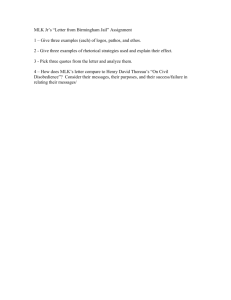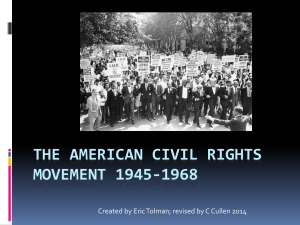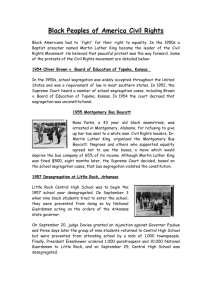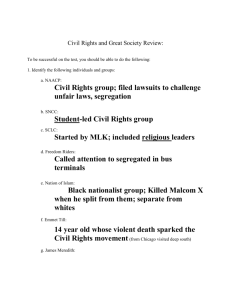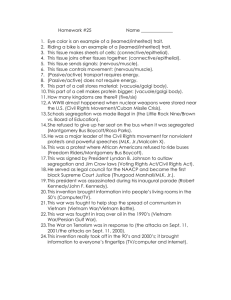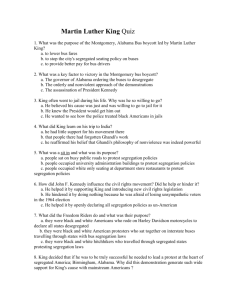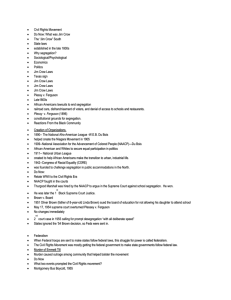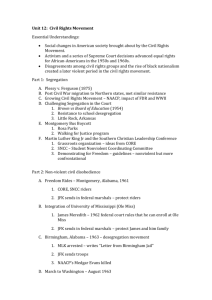chapter 20 notes
advertisement
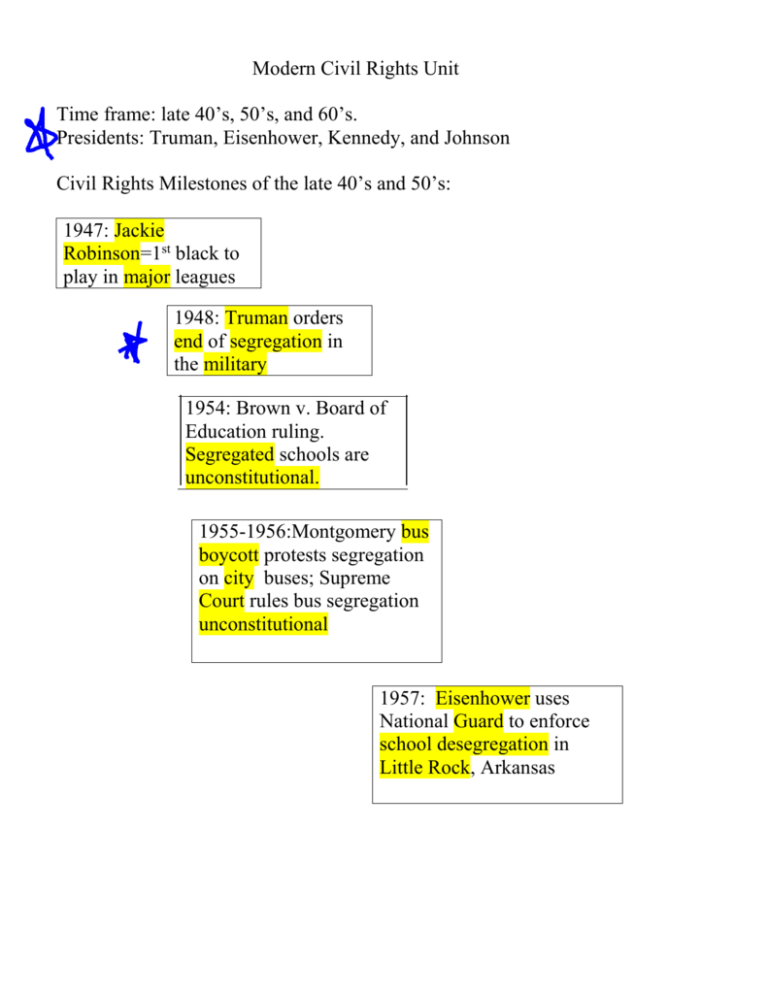
Modern Civil Rights Unit Time frame: late 40’s, 50’s, and 60’s. Presidents: Truman, Eisenhower, Kennedy, and Johnson Civil Rights Milestones of the late 40’s and 50’s: 1947: Jackie Robinson=1st black to play in major leagues 1948: Truman orders end of segregation in the military 1954: Brown v. Board of Education ruling. Segregated schools are unconstitutional. 1955-1956:Montgomery bus boycott protests segregation on city buses; Supreme Court rules bus segregation unconstitutional 1957: Eisenhower uses National Guard to enforce school desegregation in Little Rock, Arkansas CIVIL RIGHTS ORGANIZATIONS AND THEIR LEADERS The Civil Rights movement of the 1950/60’s was made up of a variety of groups, united by their desire to achieve equal rights for all Americans. Originally all these groups began as non-violent groups—some will eventually evolve into more radical movements. NAACP-1909, W.E.B. DuBois, et al=founding members Worked through the courts to secure legal equality for all Americans NATIONAL URBAN LEAGUE-1911 Assisted people moving to major American cities CORE-1942, James Farmer, director Used peaceful confrontations, such as sit-ins, to bring about change. Supported the “Double V” campaign of WWII. SCLC-1957, MLK,Jr., et al (Ella Baker, exec director) Organized nonviolent protests against racism and segregation SNCC-1960, Ella Baker and Robert Moses Gave young activists an important role in civil rights movement-tended to use techniques that demanded more immediate change. The Montgomery Bus Boycott: Rosa Parks refuses to give up her seat on the city bus. She is arrested and put on trial. Jo Ann Robinson of the WPC (Women’s Political Council) suggests the bus boycott. Martin Luther King, Jr., minister of the church where the original meeting was held, becomes spokesperson for the protest. Over the next year 50,000 blacks refused to ride the bus. Despite the company losing $$, it refused to end segregation. The Supreme Court ruled Montgomery bus segregation unconstitutional. This success introduces non violent protest for achieving equality. Little Rock troubles: Arkansas governor, Orval Faubus declared that he couldn’t keep order if he enforced integration. He orders the National Guard to turn away 9 black students to Central High School in Little Rock Pres. Eisenhower placed the National Guard under federal command and orders them to protect the 9 students The slow movement toward school integration has begun. Other voices: Other minority groups will begin to “piggy-back” on the African American civil rights movement. Hernandez v Texas will be the first Supreme Court case ruling against discrimination targeting a minority other than African Americans. Civil rights protest succeeded in battling segregation, though protesters often faced violent opposition. SIT-INS: During 1961, approx 70,000 students participated in sit-ins—about 3600 of those will be jailed. MLK said the arrests were a “badge of honor.” FREEDOM RIDES: Boynton v Virginia expanded its ruling on bus segregation to include interstate buses. Freedom rides were designed to test whether states would obey. It will lead to violence in Alabama where the riders will escape a burning bus to be beaten by a white mob. Eventually, Attorney General Robert Kennedy will order federal marshals to protect the riders and the ICC will issue a ruling prohibiting segregation in all interstate transportation. BIRMINGHAM PROTESTS * MLK, Jr., calls Birmingham, Alabama, “the most segregated city in the country.” * King is invited to Birmingham to lead protests against segregation * Birmingham police commissioner Eugene “Bull” Conner vows to arrest King and other demonstrators. * King is arrested during protest march and spends a week in jail. * MLK writes his famous “Letter from the Birmingham Jail” * After being released, MLK leads another protest march, Birmingham police respond with violence and more arrests * Nation watches police violence on television: sympathy for civil rights activists grows. * Birmingham ends policies of segregation. Political Responses: John F. Kennedy (JFK): Oct. 1960, JFK offers his support to family of MLK due to his arrest in Georgia and Robert Kennedy succeeds in getting him released on bailcauses a swing in African American votes to the Kennedy in Nov. However, the election is so close he won’t have a mandate. Opposition from Southern Democrats in Congress slow Kennedy’s civil rights agenda Khrushchev embarrasses JFK, 1961, over the violence of Freedom Rides. Kennedy introduces a strong Civil Rights Bill. Aug, 1963, March on Washington Nov, 1963, Kennedy assassinated. Lyndon Baines Johnson (LBJ): LBJ had opposed civil rights most of his political career. After JFK’s death, Johnson uses his pull, including the help of the Republican minority leader, to pass the Civil Rights Act of 1964. “Freedom Summer”=summer of 1964. Saw voter registration drives though out south and much KKK activity to stop them, including murders. Demo. National Convention in summer of 1964 made LBJ realize he had to do something about Af. Am. voting rights. 24th Amendment ratified in 1964= end to poll taxes. Voting Rights Act of 1965=federal officials had right to register blacks when local officials blocked registration. The Radical Movement Young people frustrated at the slow pace of change move toward more militant movements. James Baldwin’s The Fire Next Time and Notes of a Native Son was a powerful voice for the civil rights movement. Malcolm Little = Malcolm X. He viewed white society as oppressive. Nation of Islam=Black Muslims. Preached black separation and self-help, founded in 1933 by Elijah Muhammad in Chicago. Black nationalism=belief in the separate identify and racial unity of the African American community Generally these ideas opposed integration. 1964, Malcolm X formed his own religious society=Muslim Mosque, Inc. 1966, Stokely Carmichael, a SNCC leader moves this organizationviolent, radical movement. Coining the phrase “black power”. Fall 1966, Black Panthers, led by Bobby Seale and Huey Newton, wanted separate black communities. Severe riots will erupt during 1964 and 1965. With the most severe riots in Rochester, NY; NYC, NY; New Jersey and in ’65 the Los Angeles neighborhood of Watts. Thousands of blacks filled the streets burning cars and stores, looting, sniping at firefighters. Leave 34 dead and >1000 wounded. More riots and violence will take place in 1966, 1967, 1968. 1968, MLK is assassinated. James Earl Ray is convicted of MLK’s murder.
